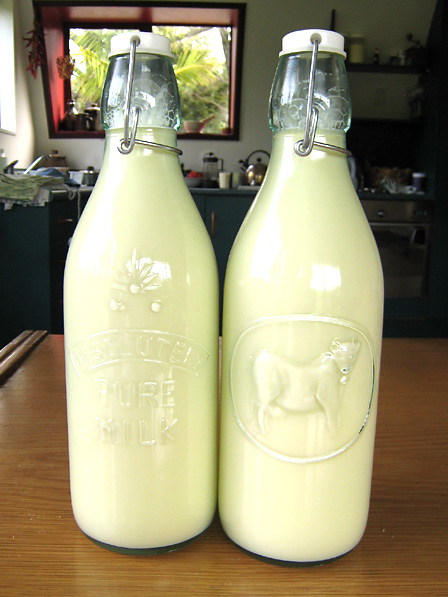WARNING: THIS POST CONTAINS GRAPHIC IMAGES THAT MAY NOT BE SUITABLE FOR SOME READERS.
Slaughtering a steer is a big job that requires a lot of skill and equipment to be done properly. A block and tackle or hoist would be necessary to haul the carcass up for skinning and gutting. A meat ax is helpful for splitting the carcass in half. After the killing, skinning and gutting are complete, the meat needs to be transported to the butcher in a sanitary manner.
Becky and I knew that all of this was far too much for us to handle on our own. We decided to call in a home kill professional to do the job and transfer the meat to our butcher in town.
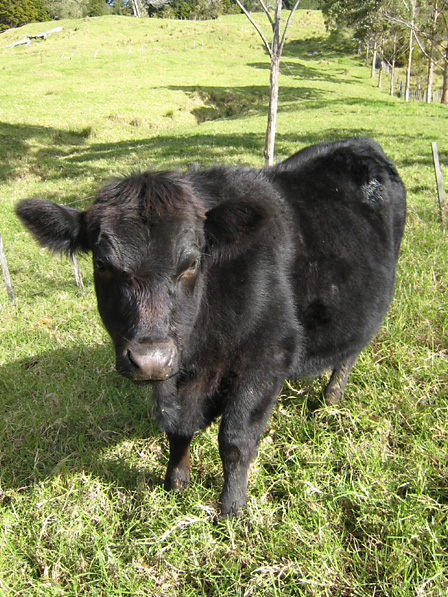
Herman Beefsteak on his last day
Lloyd Johnson has been providing home kill services in New Zealand for twenty years. He’s trying to retire from this work, but rural people continue to call on him. For a cost of $60, Lloyd will do the job neatly and efficiently.
Besides his years of experience, Lloyd brings with him a mobile slaughterhouse in the form of his specialized ute.
All the customer has to do is walk the cow to be slaughtered into the vicinity of that ute and Lloyd will do the rest.
I assumed that I’d do the same thing that I always did when I shifted the cows: Offer a treat bucket to Coco and then walk to where I wanted the rest of the cows to go. They all follow Coco. Except for that day, they didn’t. I don’t know if it was a coincidence, but they wouldn’t follow me down to the front of the paddock, where Lloyd was waiting with his rifle for Herman Beefsteak.
Long story short, eventually Lloyd and I managed to shift Herman into a desirable location for what was about to happen.
I wasn’t really sure how I would feel about slaughtering Herman Beefsteak. I felt… I suppose, matter-of-fact about the situation. From the day this animal was born, Becky and I both knew it would come to this. We gave the animal a care free, stress free life, and now it is going to feed and nourish us and our baby son, Owen. It’s not any more complicated than that for me.
Lloyd stepped close to the steer, aimed the rifle at its head—“Just above the point at which imaginary lines from alternate eyes and horns cross”—and pulled the trigger. The crack of the .22 calibre rifle was followed by great thump as the animal collapsed and rolled onto its right side.
“Get your buckets,” said Lloyd. Becky had instructed Lloyd that she would like to have blood to make black pudding. I retrieved our two stainless steel buckets. (Becky is writing a post dedicated to making the black pudding.)
Lloyd said, “The death throes can be strong. Watch those hooves.”
The animal convulsed powerfully a couple of times, and then settled down.
With one of my buckets in hand and ready, Lloyd cut a long opening, deep into the animal’s neck, severing the main veins and arteries.
Both the volume of blood and the pressure with which is emerged took me by surprise. In a short time, I had about two gallons of blood, far more than necessary for Becky’s black pudding, I was sure. Better to have too much than too little, I figured, and whatever was left over would go right onto the garden beds.
I immediately delivered the buckets of blood to Becky, who was standing by in the kitchen. You’ve got to move fast when making black pudding. She’ll tell you all about it.
Back outside, Lloyd was already at work.
I’m not going to try to describe exactly what he did. He’s such an expert at it, and so fast, that I’m at a bit of a loss to explain it, even though I watched him do it. Luckily, I took pictures.
At the time, I kept thinking, “How is this going to be a one man job?”
Lloyd makes use of clever implements. Probably, the most clever of all is the small hoist and winch system that he custom built onto the back of his ute. This machine deploys in a matter of seconds and allows him to raise the animal up for gutting. The back of the ute itself is all stainless steel, which facilitates the transport of the beef to the butcher in a sanitary manner.
He has metal chocks to position the beast on its back so that it doesn’t roll over as he’s skinning it on the ground.
He uses some kind of stainless steel rods with hooks on both ends to pull bits this way or that. (There’s probably a name for these, but I just don’t know what they’re called.) If he needs some tension applied to the flesh, he hooks one end of the rod in and then he hooks the other end onto a tendon or hoof or another bit of flesh that’s going to pull the way he wants. Look carefully at the pictures and you’ll see this much clearer than I can hope to explain it.
He has an obviously custom built, all metal ax. The blade looks like a heavy duty meat cleaver, but it has a full length ax handle. This is used to actually split the dressed carcass in half.
A high quality stainless steel saw was used once—and only very briefly—on the breast bone, I believe.
He sharpened his knife continuously with a sharpening steel that he wore around his waist.
He had a stainless steel brace that he wore over his shoulders and waist. This assists him with carrying the meat—in quarters—from the hoist to the back of the ute for transport.
He tows a trailer in which the animal’s head, hide and internal organs are carried away. He sells the hide. I don’t know what becomes of the head and the guts. We kept the heart, liver and kidneys.
The process was remarkably neat (considering the scale of the task) and seemed to happen very fast. How fast? You might not believe it, but the job was done in about thirty minutes.
Here’s the story, as told by the images. They run in order.
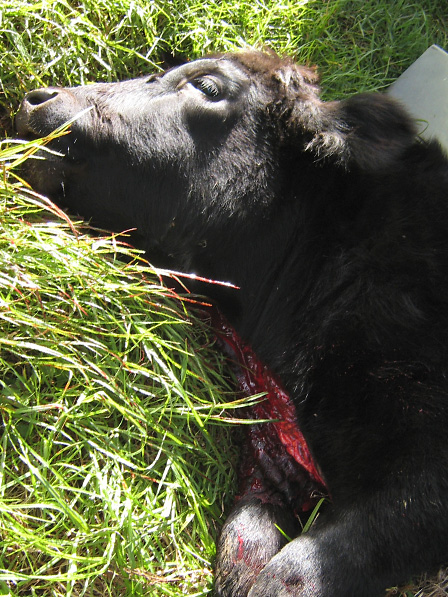


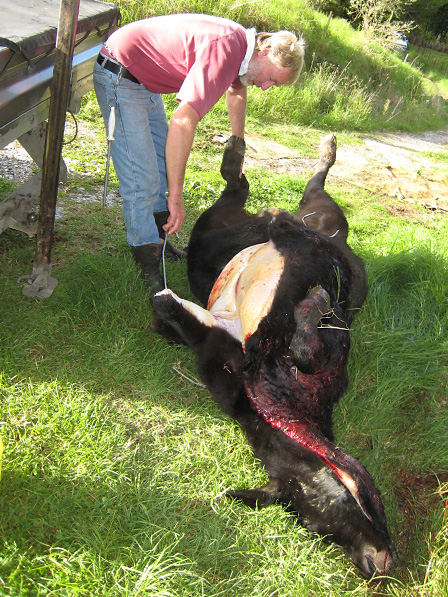








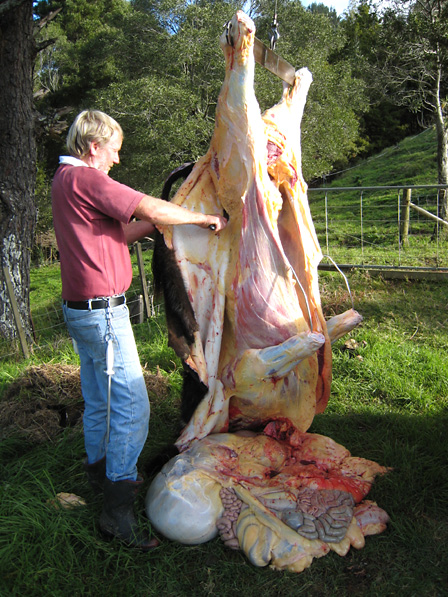




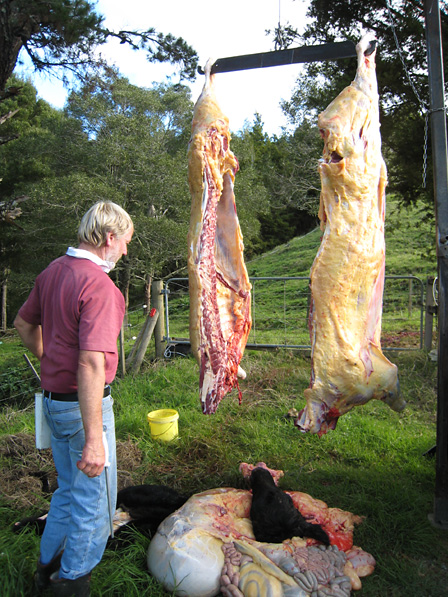
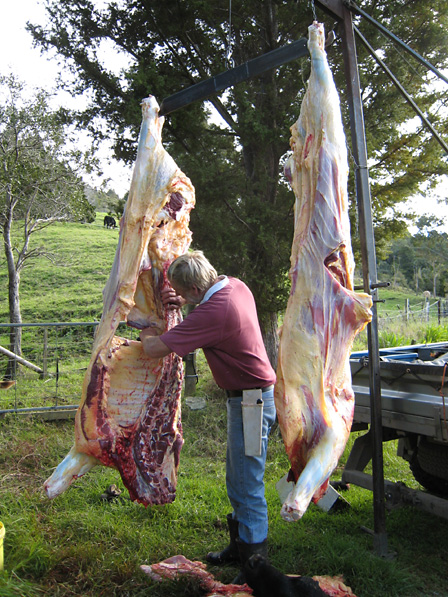


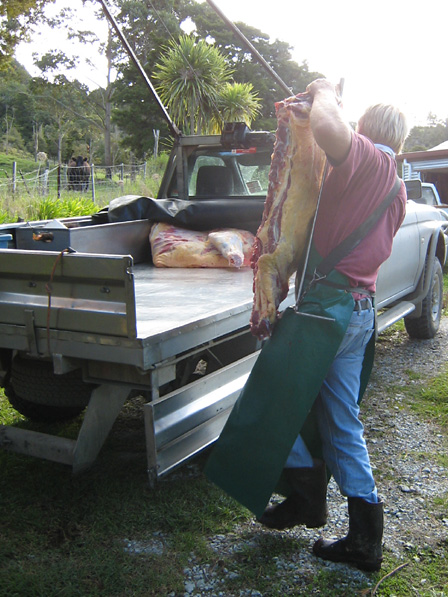

And away it all went to our butcher in town…



